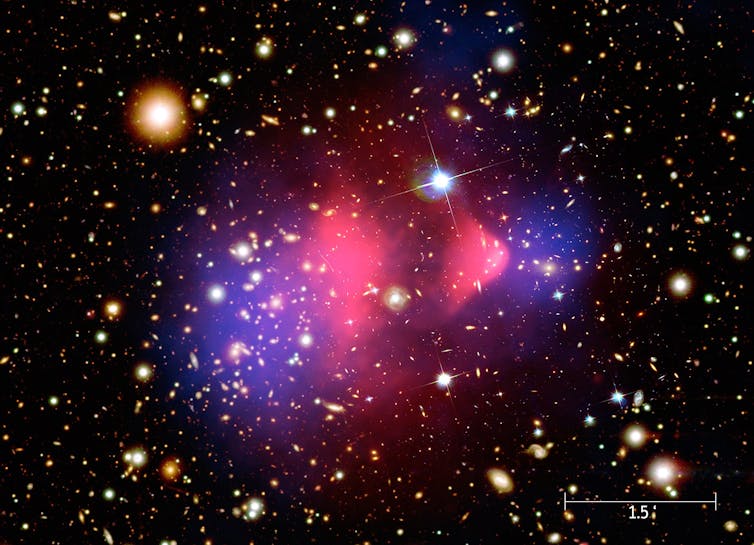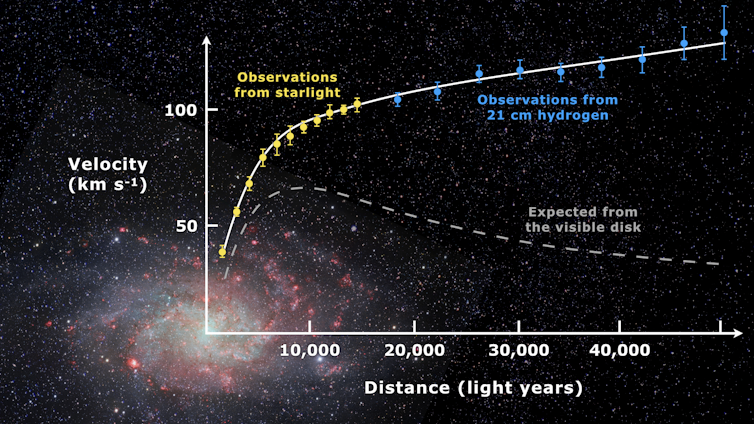 |
| Photo from https://www.zazzle.com/dark+matter+clothing |

****************************
Dark matter may not actually exist – and our alternative theory can be put to the test
Juri Smirnov, University of Southern Denmark
 |
| The bullet cluster. NASA/CXC/M. Weiss |
But there are other approaches to make sense of why galaxies behave so strangely. Our new study, published in the Journal of Cosmology and Astroparticle Physics, shows that, by tweaking the laws of gravity on the enormous scales of galaxies, we may not actually need dark matter after all.
The Swiss astronomer Fritz Zwicky discovered in the 1930s that velocities in galaxy clusters were too high to account for how much matter we could see. A similar phenomenon was described by several groups of astronomers, such as Vera Rubin and Kent Ford, when they studied the motion of stars at the far edges of the Andromeda Galaxy.
The velocities of the stars far from its centre were expected to decrease, as they experience less gravitational force. That’s because, according to Newton’s second law of motion, the gravitational pull on orbiting matter can be equated to a product of its mass and acceleration (which is related to velocity).

However, the measurements showed that there was no such decrease in velocities with distance. That led scientists to believe there must be some invisible matter there to create a stronger gravitational pull and faster stellar motion. In the past decades, countless other probes of gravitating systems at very large length scales indicated the same problem.
Beyond dark matter
The mystery of what dark matter actually is remains the ultimate challenge of modern fundamental physics. The core question is whether it is indeed a missing mass source, such as a new type of matter, or whether the gravitational law is simply different at gigantic length scales.
While the first option seems very tempting, we haven’t actually found any dark matter yet. Also, while gravity laws are well tested within the solar system, one has to be careful extrapolating this to scales which are at least one billion times larger.
One well known attempt to get rid of the need for dark matter is Modified Newtonian Dynamics (MOND), which suggests that Newton’s law of gravity becomes irregular when the gravitational pull is very weak – as is the case in the outer regions of the galaxy. But this theory, although successful in many respects, hasn’t passed the same stringent tests as our standard model of cosmology, which includes dark matter.
The main problem is that MOND cannot explain the missing mass problem in galaxies and galaxy clusters at the same time. Another very strong argument against MOND is based on the observation of colliding galaxy clusters, where the stars of each galaxy pass through each other, but the gas clouds stick together and stay behind. A famous example is the Bullet Cluster, which consists of two such colliding clusters. Observations suggest that dark matter follows the stars in these events, which have a lower total mass than the gas cloud. MOND cannot explain why that is.
Space bubbles
We set out to tweak the laws of gravity in a different way. Our approach assumed that a phenomenon known as Vainshtein screening is at work. This suggests that each sufficiently dense, compact object in space generates an invisible sphere around it which determines how the laws of physics behave with growing distance. This sphere is a theoretical concept to help us understand the difference between small and big scales, rather than an actual physical membrane.
According to our theory, within this bubble the laws of ordinary Newtonian gravity that we see in our solar system hold for objects interacting with the massive body at the centre. Outside the bubble, the theory suggests that the gravitational pull by the central object can be significantly enhanced – even though there is not more mass present.
The bubble size would be proportional to the mass of the central object. If, for example, in a galaxy this sphere has a radius of a few thousand light years – a typical distance at which signs of dark matter is observed – the corresponding sphere of our sun would have a radius of 50.000 astronomical units (one such unit is the distance between the sun and the Earth). However, the edge of the solar system is only 50 astronomical units away. In other words, there are no objects we could observe that far from the sun to test whether the sun has a different gravitational pull on them than it has on Earth. Only the observation of entire systems very far away allows us to do that.
The surprising effect is that the size of the Newtonian bubble grows with the enclosed mass in a particular way. This means that the law of gravity changes at different length scales in galaxies and clusters of galaxies respectively and therefore it can explain the apparent dark matter in both systems simultaneously. That’s not possible with MOND. Furthermore, it is consistent with the observation of the Bullet Cluster. That’s because the gas clouds left behind in the collision are not compact enough to generate a sphere around them – meaning that the apparent dark matter is only notable around the more compact stars. MOND doesn’t distinguish between stars and gas clouds.
To our big surprise, our theory allowed us to explain the stellar velocities in galaxies a lot better than with Einstein’s general relativity, which allows for dark matter to exist. So there may actually be less mysterious dark matter out there than we think – and maybe even none at all.

We plan to further investigate this interesting phenomenon. It could also be responsible for the high variability of galactic motion, for which we gather more and more evidence.
Any massive body warps the space and time around it, according to general relativity. As a result, light rays take an apparent turn around the object rather than travelling in a straight line – an effect dubbed gravitational lensing. An extremely interesting test of our finding would be the observation of precise gravitational light deflection by individual galaxies, which is albeit a difficult measurement. Our theory predicts a stronger light deflection for very compact galaxies so, excitingly, it could one day be falsified or confirmed by such a measurement.
Juri Smirnov, Post doctoral researcher of Physics, University of Southern Denmark
This article is republished from The Conversation under a Creative Commons license.
Read the original article.
********************************************
ADDENDUM
Monday 18th February 2019
ADDENDUM
Monday 18th February 2019
Only today I came across another theory called Quantised Inertia that also does away with dark matter. In this YouTube video, the originator of the theory (Mike McCulloch) explains a little about it:
There's quite a lot of information out there about this theory and now that I'm aware of it I can investigate further.
********************************************
ADDITIONAL ADDENDUM
Thursday 4th April 2019
This interesting article titled It's Real: Astronomers Just Discovered a Second Galaxy With No Dark Matter and mentions that both galaxies are "ultra-diffuse galaxy - quite large, spread-out, and faint to observe ... about the size of the Milky Way, but with 100 to 1,000 times fewer stars". The findings are said to strengthen the case for dark matter but I'm at a loss to see that. To me, it strengthens the argument that one of the two alternative theories described in this article might be right.